It doesn’t really matter where you are in the world; if there is water nearby, you are sure to have ducks coming and going year after year.
There are more than 130 species of duck worldwide, and while they come in various sizes and colors, they can be divided into six groups depending on their behavior. Dabbling ducks, diving ducks, sea ducks, shelducks, perching ducks, and stiff tails.
From lakes, ponds, and rivers to wetlands, marshes, and bays, join me as we discover the delightful duck species ready to inhabit these habitats.
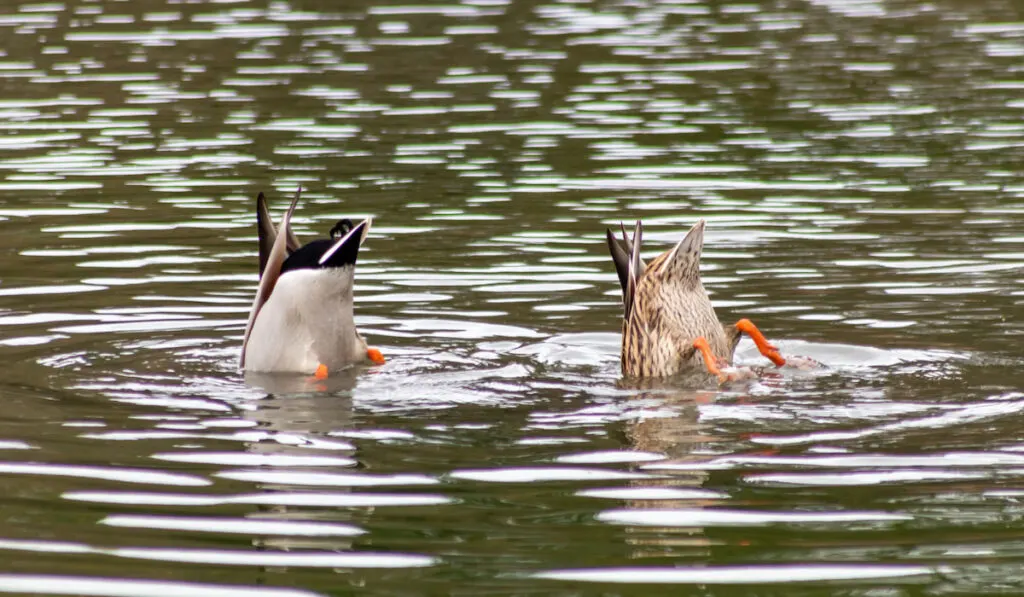
Table of Contents
Dabbling Ducks
The first species of duck that we will be looking at is the dabbling duck.
Dabblers are found in shallower waters than other ducks and are easily recognizable.
Identifying Dabblers
Have you ever seen ducks on a pond or lake dipping their heads under the water’s surface and pointing their tail feathers to the sky? They are dabbling ducks, and they’re feeding!
This signature move enables these ducks to reach underwater and choose from various aquatic vegetation, larvae, or insects. And keeping their heads submerged until they are satisfied is quite a balancing act!
While they stretch out under the water’s surface, they keep their legs and feet wide apart in order to maintain balance. Above the water, their tails are visible, moving from side to side to counterbalance their head movements.
Dabblers are also surface feeders equipped with a bill specially designed to do so! Their flat bills have a comb-like straining system, known as pecten, that allows them to trap food while straining out unwanted water.
When dabbling ducks are on land, they are usually foraging for seeds, grain, nuts, and insects.
1. Mallard (Anas platyrhynchos)
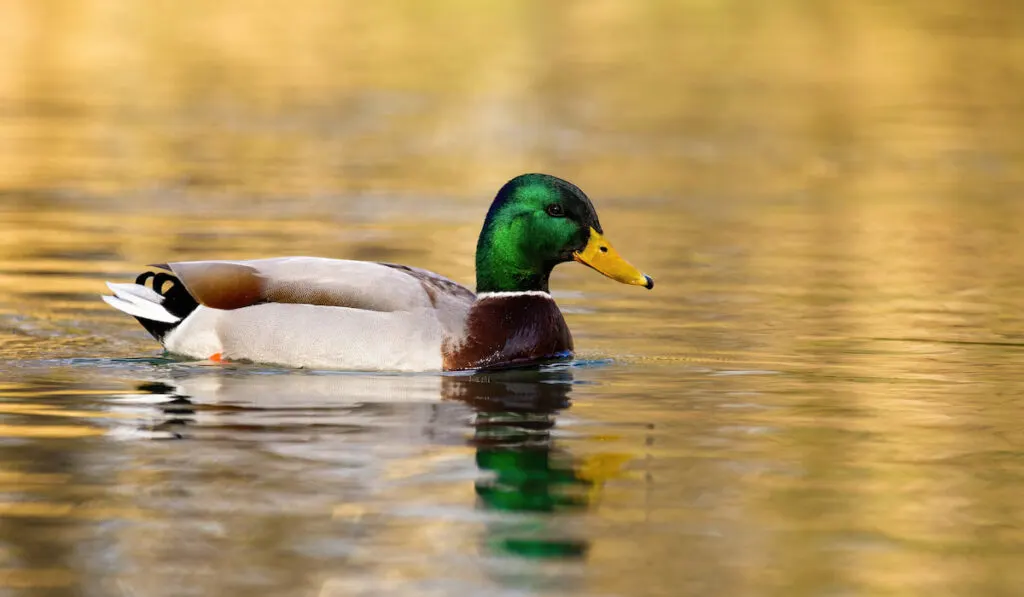
- Migration pattern: While living in subtropical and temperate areas of North America, Europe, and Asia most of the year, Mallards spend winter further south. Its numbers are also growing in Australia and New Zealand.
- Male color: Iridescent green heads, yellow bills, gray bodies, brown breasts, and a blue speculum with a white surround on their wings.
- Female color: Mottled brown all over, orange bills, and blue speculum.
- Diet: Omnivore
- Habitat: Lakes and ponds
- Weight: 35.3 – 45.9 oz (2.2 – 2.8 lbs)
- Length: 19.7 – 25.6 inches
- Wingspan: 32.3 – 37.4 inches
- Nesting: Ground
- Clutch size: 1 to 13 eggs
- Incubation period: 23 to 30 days
- Lifespan: 5 to 10 years
2. American Black Duck (Anas rubripes)
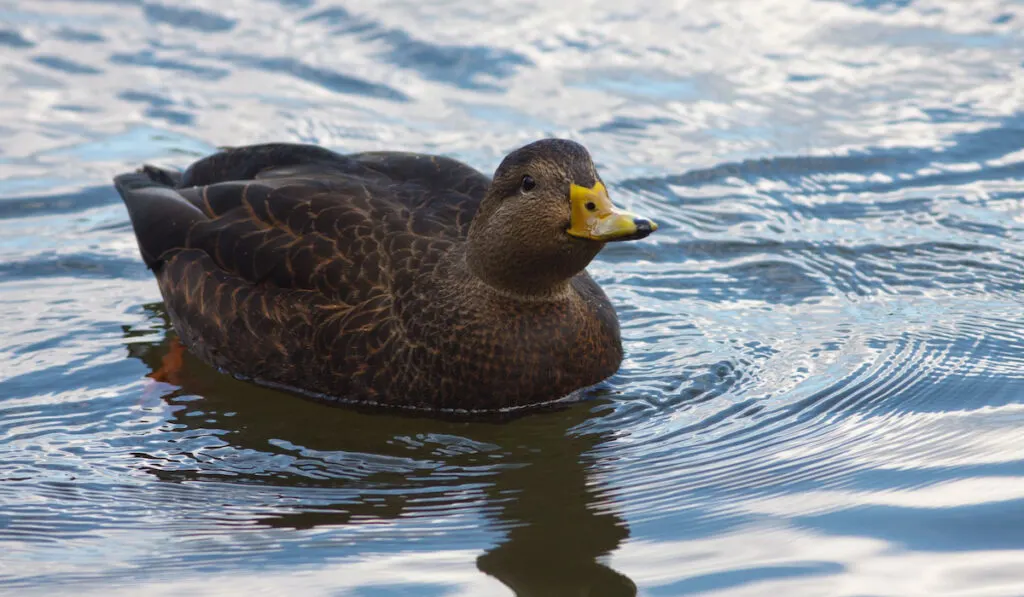
- Migration pattern: While American Black ducks spend most of their time in the eastern regions of North America, eastern Canada is their breeding ground. Some choose to remain in northeastern states in the U.S. all year round.
- Male color: Dark brown bodies with a lighter shade of brownish gray on their heads, a blue patch on their wings, a yellow bill, and orange legs.
- Female color: Dark brown bodies with a lighter shade of brownish gray on their heads, a blue patch on their wings, an olive bill, and orange legs.
- Diet: Insects
- Habitat: Lakes and ponds
- Weight: 49.6 oz (3.1lbs)
- Length: 19 – 25 inches
- Wingspan: 33 – 36 inches
- Nesting: Ground
- Clutch size: 6 to 14 eggs
- Incubation period: 23 to 33 days
- Lifespan: 10 to 20 years
3. Cinnamon Teal (Spatula cyanoptera)
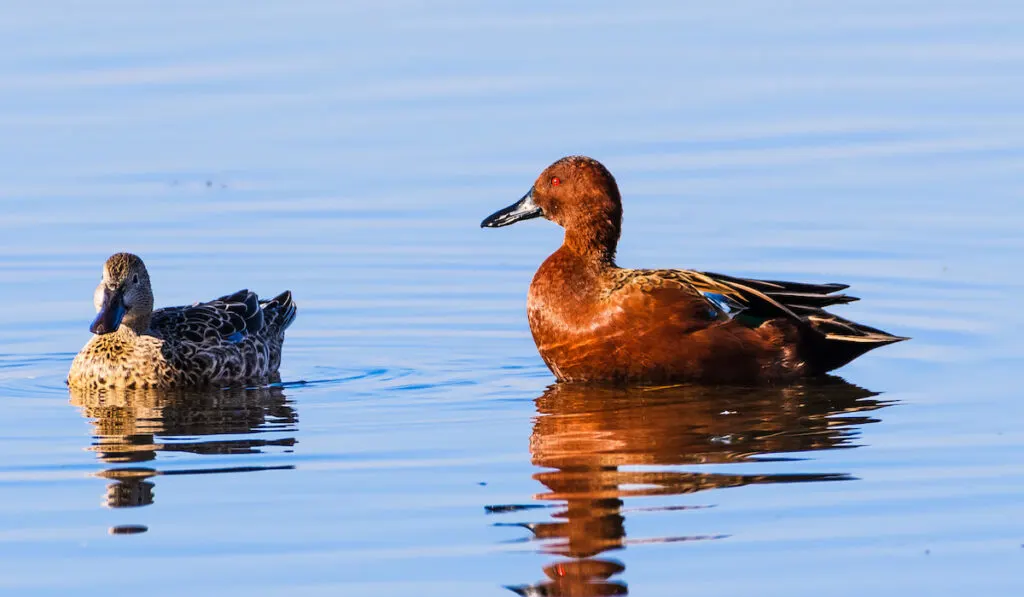
- Migration pattern: Before wintering in Mexico and South America, cinnamon teals breed in the western states of America and southern Canada. But some ducks stay all year long in America’s west, Mexico, and South America.
- Male color: Red eyes, cinnamon bodies, brownish-red back, greenish wing tips, and a black bill.
- Female color: Scaly brown pattern bodies, light brown heads, and black bill.
- Diet: Omnivore
- Habitat: Marshes
- Weight: 16.4 oz (1lb)
- Length: 14 – 17 inches
- Wingspan: 24 – 30 inches
- Nesting: Ground
- Clutch size: 4 to 16 eggs
- Incubation period: 21 to 25 days
- Lifespan: 5 to 10 years
4. Gadwall (Mareca strepera)
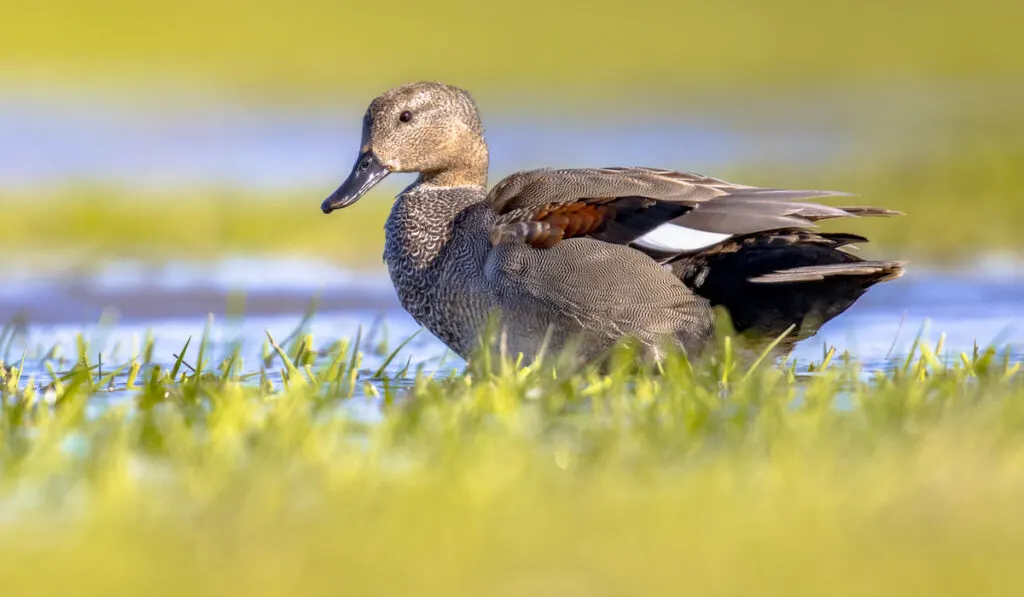
- Migration pattern: Gadwalls breed across the United States and Canadian plains before migrating to the central and southern states of America and Mexico. Some stay on the West Coast all year.
- Male color: Dark-brown heads, scaley blackish-brown patterns on their chests and shoulders, gray or white bellies, black tail feathers, and a white patch on the underside of their wings visible when in flight.
- Female color: Golden brown and darker brown scaley patterns all over their bodies.
- Diet: Plants
- Habitat: Marshes
- Weight: 35.3 oz (2.2lbs)
- Length: 19 – 23 inches
- Wingspan: 31 – 36 inches
- Nesting: Ground
- Clutch size: 7 to 12 eggs
- Incubation period: 24 to 27 days
- Lifespan: 10 to 22 years
5. Northern Pintail (Anas acuta)
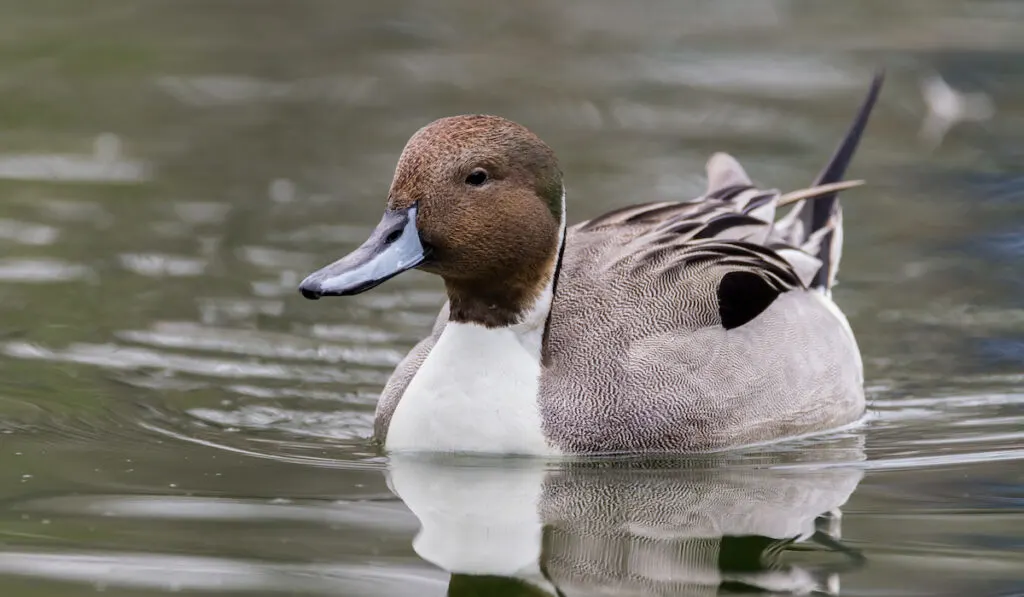
- Migration pattern: Canada, Alaska, and the Midwest from April to June during the breeding season before migrating to southern and coastal US states. Northern Pintails can also be found in Europe and Asia, while they winter in America, Mexico, Central America, Western Europe, Africa, and southern Asia.
- Male color: Dark brown heads, white stripes on their necks leading down to white bodies, gray, white, and black backs, and a green patch on their wings.
- Female color: Light and dark brown bodies with a scaled pattern.
- Diet: Omnivore
- Habitat: Marshes
- Weight: 36.3 oz (2.2lbs)
- Length: 20 – 26 inches
- Wingspan: 29 – 35 inches
- Nesting: Ground
- Clutch size: 3 to 12 eggs
- Incubation period: 22 to 24 days
- Lifespan: 10 to 22 years
6. American Wigeon (Mareca americana)
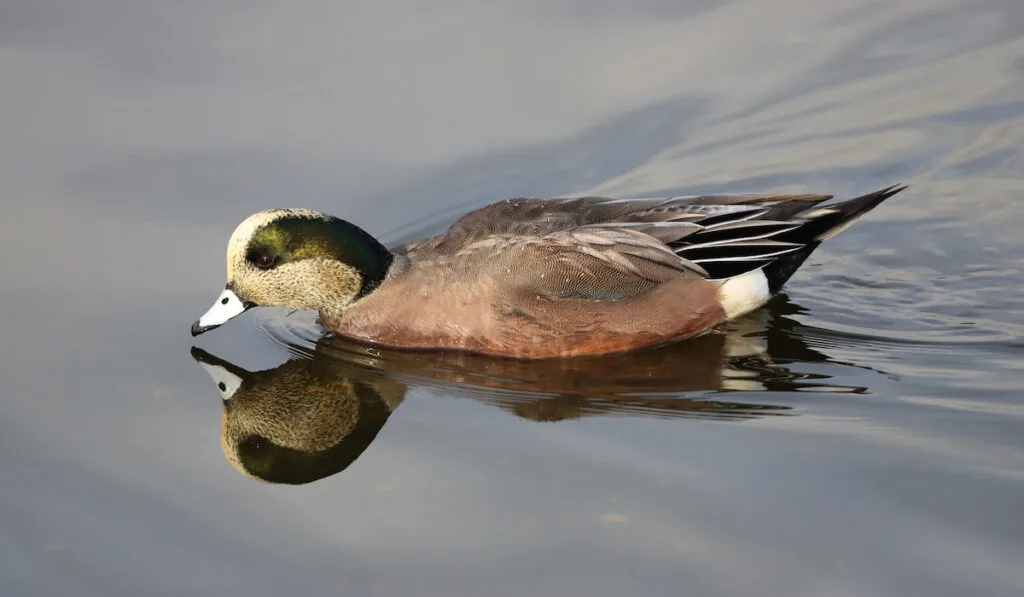
- Migration pattern: From the end of May to June, American Wigeons breed in Alaska, western Canada, and the northwestern US. They winter in southern USA, Mexico, and Central America.
- Male color: Green stripes on the sides of their speckled heads, grayish-brown bodies, and pale blue bills.
- Female color: Grayish brown speckled heads and brown bodies, and pale blue bills.
- Diet: Plants
- Habitat: Lakes and ponds
- Weight: 19 – 46.9 oz (2.9lbs)
- Length: 16.5 – 23.2 inches
- Wingspan: 33 inches
- Nesting: Ground
- Clutch size: 3 to 13 eggs
- Incubation period: 22 to 28 days
- Lifespan: Up to 21 years
7. Black-Bellied Whistling Duck (Dendrocygna autumnalis)
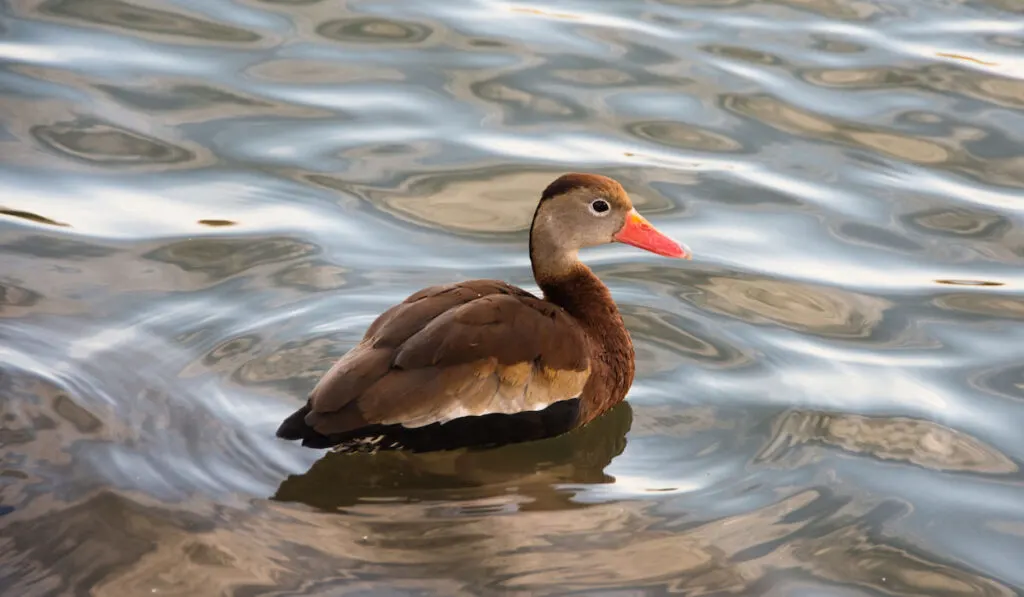
- Migration pattern: Texas and other southern states of America close to the border of Mexico from April to October and South America.
- Male color: Red bill, gray face, white eye ring, a reddish-brown neck, breast, and back, pink legs, and a black belly.
- Female color: Red bill, gray face, white eye ring, a reddish-brown neck, breast, and back, pink legs, and a black belly.
- Diet: Plants
- Habitat: Marshes
- Weight: 28.8 oz (1.8lbs)
- Length: 18 – 21 inches
- Wingspan: 34 – 36 inches
- Nesting: Cavity
- Clutch size: 9 to 18 eggs
- Incubation period: 25 to 30 days
- Lifespan: 15 years
8. Northern Shoveler (Spatula clypeata)
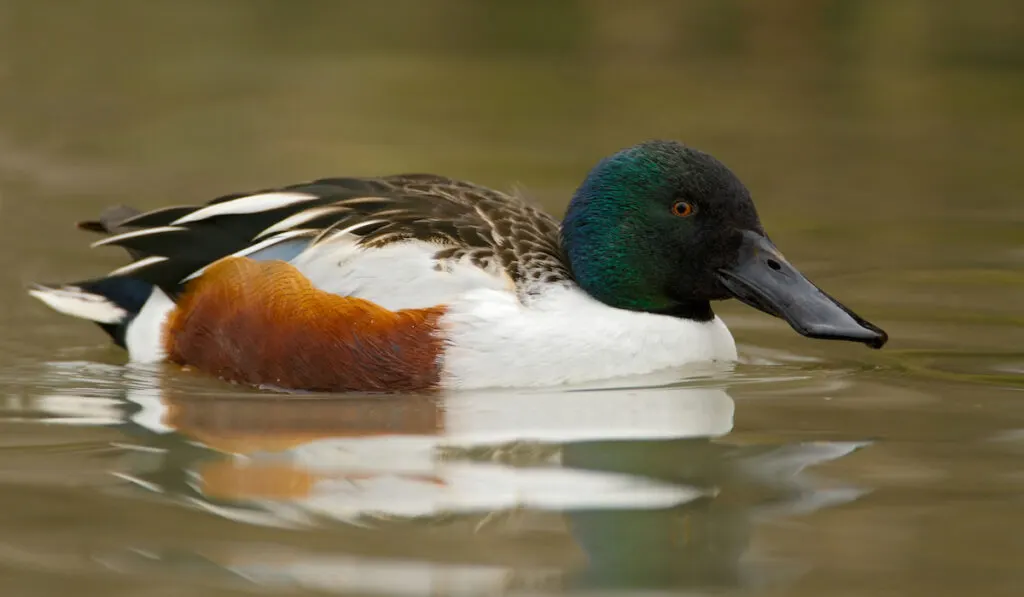
- Migration pattern: During the breeding season, they go to the northwest US states and a western portion of Canada. Some breed around the Great Lakes as well. From the Southern US, the Pacific, and Atlantic Coasts north to Canada are where Northern Shovelers spend the winter.
- Male color: Green heads, spoon-shaped black bills, brown sides, white breasts, and black backs.
- Female color: Orange bills, mottled brown bodies, and a blue shoulder patch.
- Diet: Omnivore
- Habitat: Marshes
- Weight: 14 – 29 oz (0.8 – 1.8lbs)
- Length: 17 – 20 inches
- Wingspan: 27 – 33 inches
- Nesting: Ground
- Clutch size: 8 to 12 eggs
- Incubation period: 22 to 25 days
- Lifespan: 2 to 20 years
9. Green-winged Teal (Anas crecca)
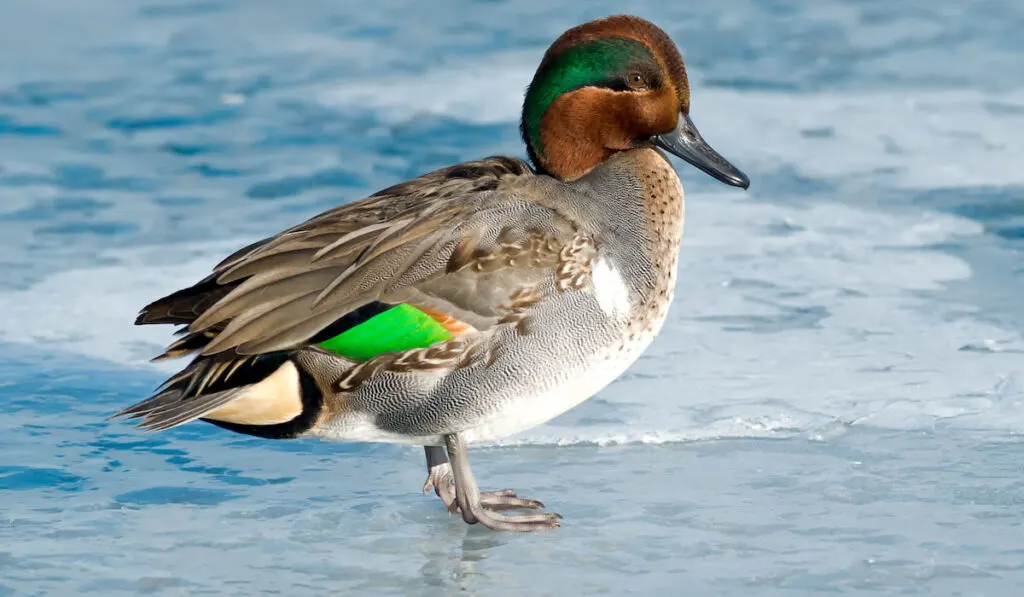
- Migration pattern: Most Green-winged Teal travel to the southern states of America and the Pacific Coast from their breeding sites in Alaska, Canada, and the northern US states. However, some ducks spend the entire year close to the Rocky Mountains.
- Male color: Brown heads with a green stripe on either side. Their bodies are brownish-gray with green patches visible under their wings.
- Female color: Brown bodies with yellow along their tail feathers.
- Diet: Seeds
- Habitat: Marshes
- Weight: 4.9 – 17.6 oz (0.3 – 1.1lbs)
- Length: 12 – 15 inches
- Wingspan: 20 – 23 inches
- Nesting: Ground
- Clutch size: 6 to 9 eggs
- Incubation period: 20 to 23 days
- Lifespan: Up to 27 years
10. Mottled Duck (Anas fulvigula)
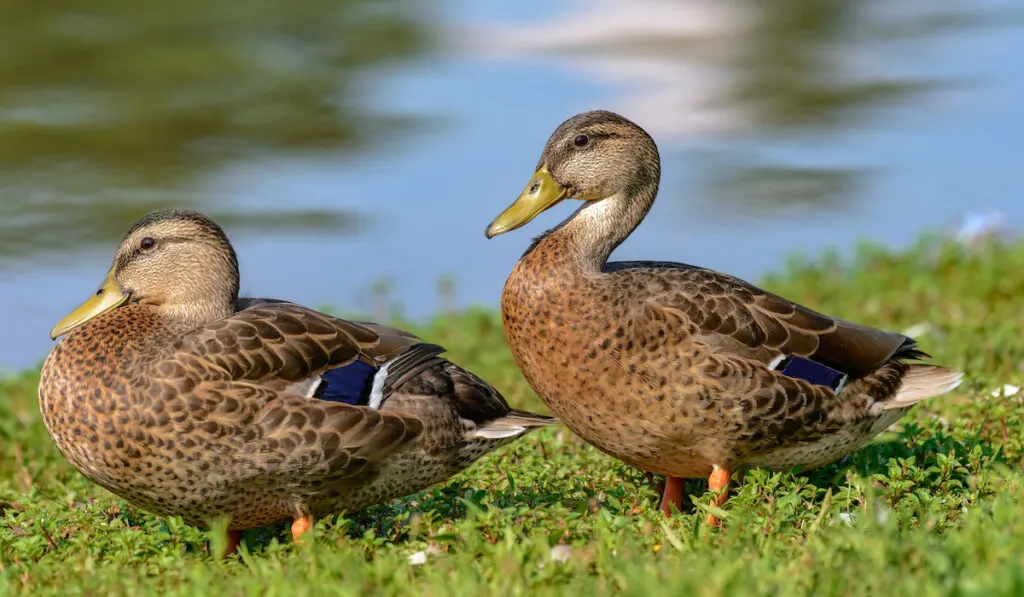
- Migration pattern: Mottled Ducks tend to remain along the Gulf Coast all year-round while occasionally moving inland.
- Male color: Dark brown bodies and light brown heads with a darker line across their eyes, yellow bill, and a blue area on their wings.
- Female color: Dark brown bodies and light brown heads with a darker line across their eyes, dull olive bill, and a blue area on their wings.
- Diet: Omnivore
- Habitat: Marshes
- Weight: 36.8 oz (2.3lbs)
- Length: 20 – 22 inches
- Wingspan: 30 inches
- Nesting: Ground
- Clutch size: 8 to 12 eggs
- Incubation period: 25 to 26 days
- Lifespan: 5 to 20 years
11. Eurasian Wigeon (Mareca penelope)
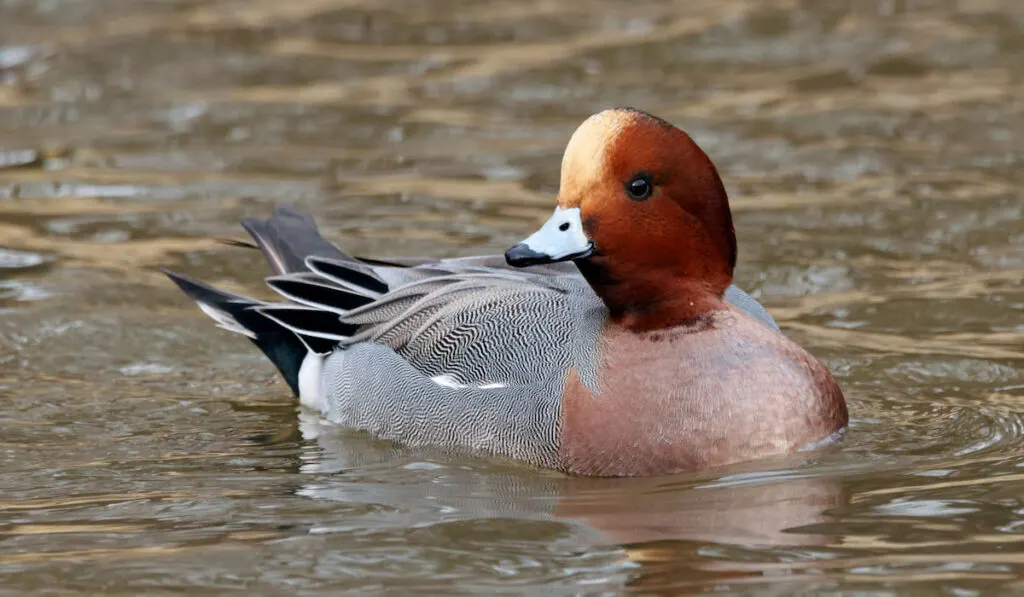
- Migration pattern: Breeding from May to June in Iceland, the UK, northern Europe and northern Asia, the Eurasian Wigeon winters in southern Europe, northern Africa, Middle East, India, China, and Japan. They are sometimes spotted on US soil.
- Male color: Cinnamon-red head with a creamy patch, blue-gray bill, gray sides and backs, white shoulder patches, and pinkish breasts.
- Female color: Brown bodies, white bellies, and a scaly pattern all over.
- Diet: Plants
- Habitat: Lakes and ponds
- Weight: 35.2 oz (2.2lbs)
- Length: 18 – 20 inches
- Wingspan: 30 – 32 inches
- Nesting: Ground
- Clutch size: 6 to 12 eggs
- Incubation period: 20 to 23 days
- Lifespan: Up to 25 years
Diving Ducks
The second group of ducks is the diving duck.
Unlike the dabbling duck, divers are found in slightly deeper waters like lakes and estuaries. And as their name suggests, they dive to feed.
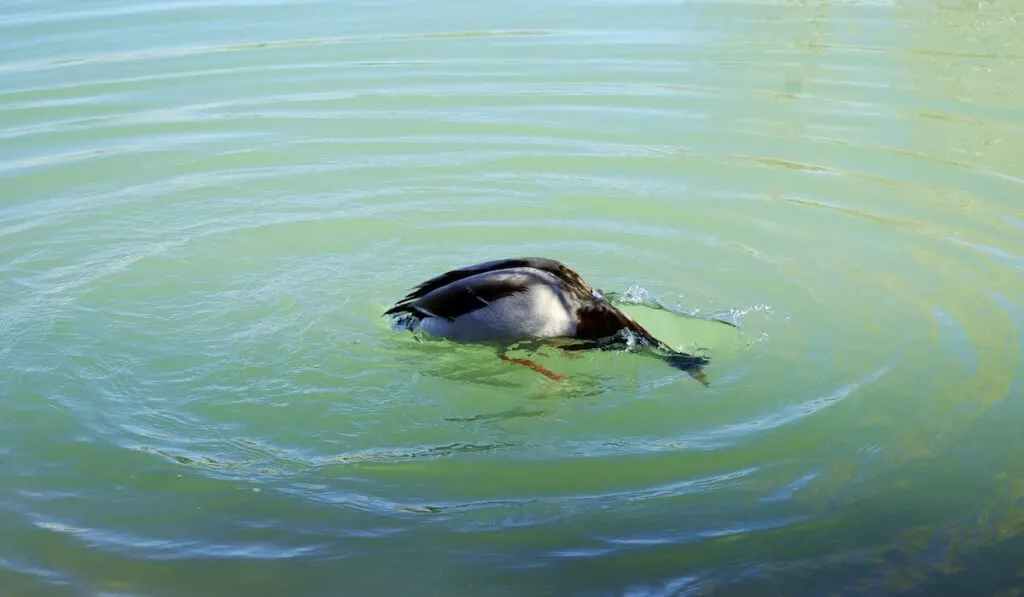
Identifying Divers
As a child, my father would tell me to watch the ducks on the lake and wait to see what would happen. One by one, they would disappear under the water, and with great excitement, I would try to guess when the ducks would reappear. I always wondered what they were doing under there.
It turns out that diving ducks have an exceptional technique when it comes to feeding time.
When these ducks dive, they can go down to a depth of 66 feet (20 meters), lasting from 10 to 30 seconds.
However, a typical diving duck can hold its breath for one minute if it needs to.
You can tell diving ducks apart from dabbling ducks by their wings, feet, and body shape.
Divers have smaller wings than dabblers to make them more efficient underwater, but as a result, divers cannot take off immediately from the water like dabblers can. Instead, as they flap their wings, they run along the surface of the water before taking to the air. They land by skidding across the water.
Also, diving duck legs are set further back towards the rear of their bodies, so when underwater, their legs become very efficient propellers.
Their wings and legs combined with wider bodies than the dabbling ducks, make divers look awkward when walking on land. They prefer to be on the water.
Before diving, these exceptional creatures exhale any air they are holding, so they will be less buoyant. When fully submerged, they use their strong legs to propel themselves, and some species use their wings to steer.
As they descend, they are on the lookout for aquatic plants, fish, insects, mollusks, crustaceans, and other invertebrates.
12. Redhead (Aythya americana)
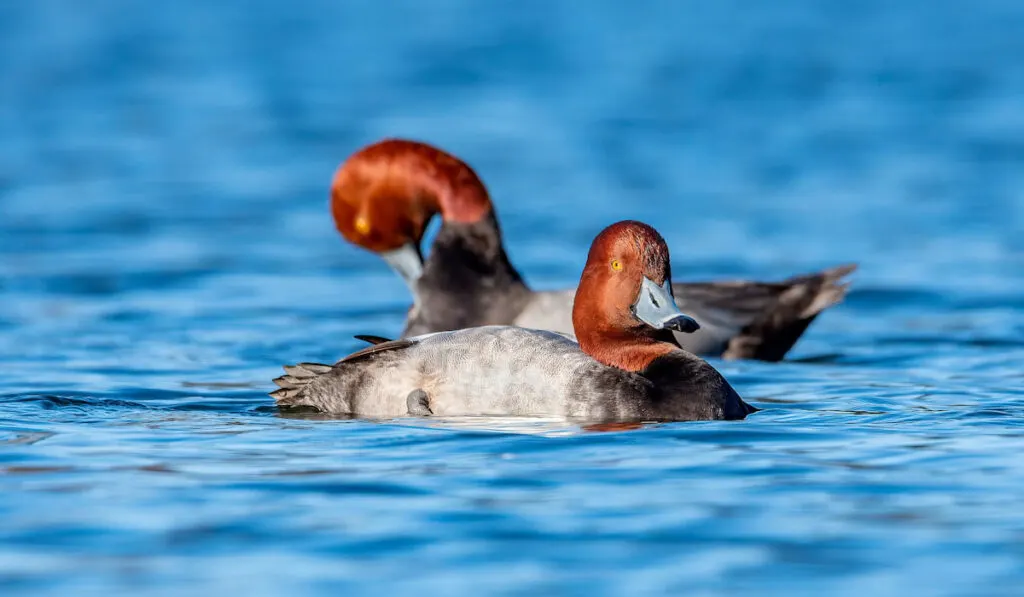
- Migration pattern: These very sociable birds breed in Canada, Alaska, and the western states of North America. They winter in huge flocks in the southern and east coast states of America, Mexico, and the Caribbean.
- Male color: Along with its most distinct feature, a redhead, this medium-sized duck also has a black chest and throat, a blueish-gray bill with a black tip, and a gray body.
- Female color: Shades of light and darker brown with a blueish-gray bill and a black tip.
- Diet: Plants
- Habitat: Lakes and ponds
- Weight: 43 oz (2.6 lbs)
- Length: 18 – 22 inches
- Wingspan: 29 – 35 inches
- Nesting: Floating
- Clutch size: 7 to 8 eggs
- Incubation period: 22 to 28 days
- Lifespan: 10 to 20 years
13. Common Merganser (Mergus merganser)
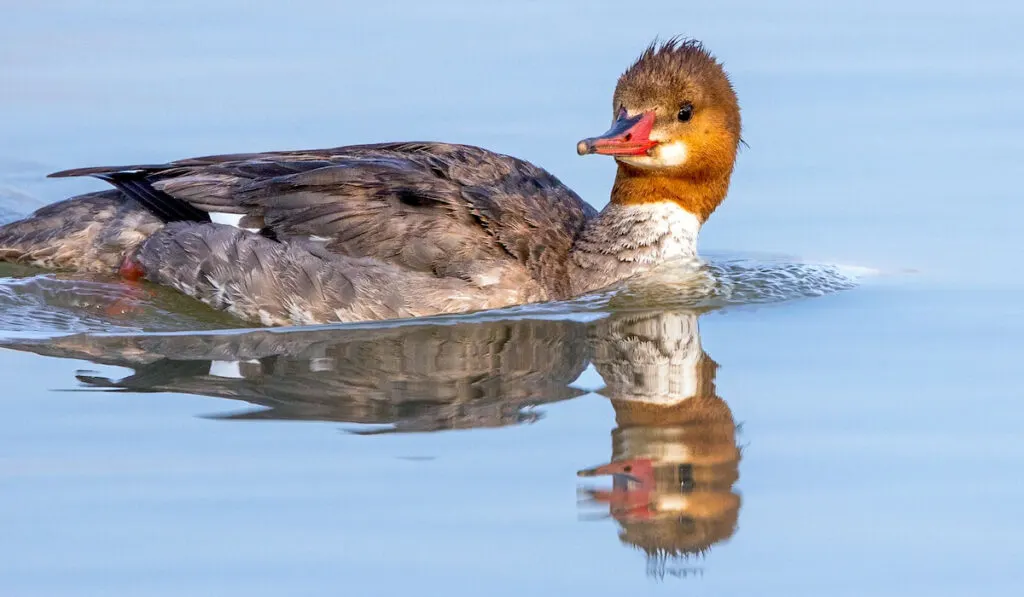
- Migration pattern: Breeding season is from early April to early June in Alaska, Canada, northern and central Europe, Siberia, and western China. Common Mergansers winter in America, south-east Europe, Central Asia, the east coast of China, Korea, and Japan.
- Male color: Greenish-black heads, bright red bills, white bodies up to their necks but with a black stripe along their backs.
- Female color: Reddish-brown cap, red bill, a white chin patch, white breast, and gray backs.
- Diet: Fish
- Habitat: Lakes and ponds
- Weight: 60 oz (3.7 lbs)
- Length: 22 – 27 inches
- Wingspan: 31 – 37 inches
- Nesting: Cavity
- Clutch size: 6 to 17 eggs
- Incubation period: 28 to 30 days
- Lifespan: 12 to 14 years
14. Red-breasted Merganser (Mergus serrator)

- Migration pattern: From the end of May to mid-July, they breed further north than most Mergansers in northern Europe, Siberia, Alaska, Canada, Greenland, and Iceland. They winter further south in coastal areas of Europe, North America, Mexico, Japan, Korea, and south-eastern China.
- Male color: Bottle-green heads and mohawk-style crests, red eyes, orange bills, white ring around their necks, rust-colored chests, black, white, and mottled gray bodies.
- Female color: Grayish brown all over.
- Diet: Fish
- Habitat: Lakes and ponds
- Weight: 47.5 oz (2.9 lbs)
- Length: 16 – 26 inches
- Wingspan: 31 – 35 inches
- Nesting: Ground
- Clutch size: 3 to 24 eggs
- Incubation period: 28 to 35 days
- Lifespan: Up to 9 years
15. Common Goldeneye (Bucephala clangula)
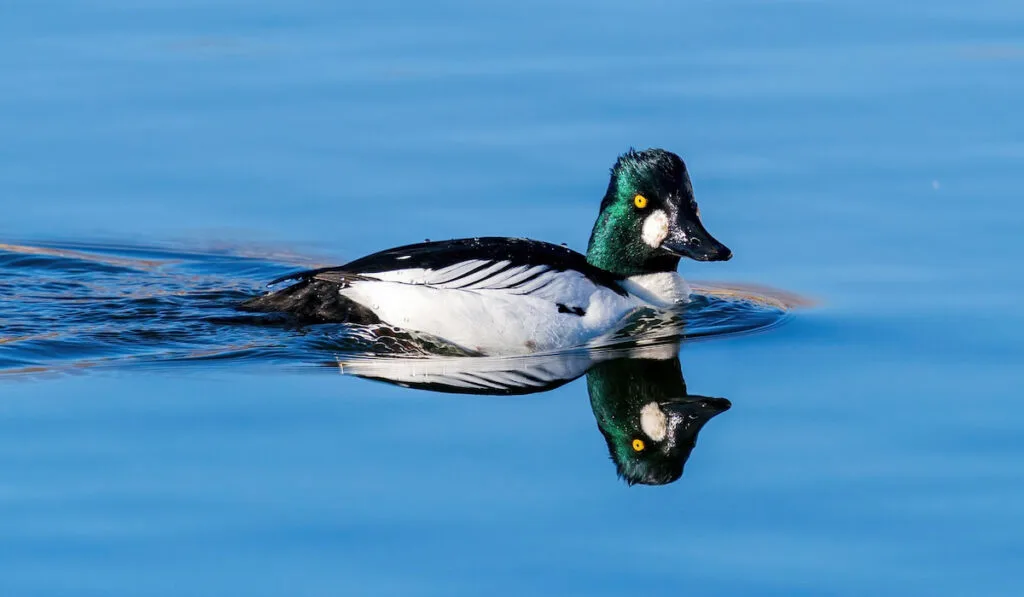
- Migration pattern: Common Goldeneyes breed in the Taiga region of Canada, North America, Scandinavia, and north Russia between May and June and migrate to more temperate latitudes for winter.
- Male color: Vibrant yellow eyes, white cheeks, black bills, greenish-black heads, white chests and sides, with black backs and tail feathers.
- Female color: Brownish gray with brown heads and black bill.
- Diet: Aquatic invertebrates
- Habitat: Lakes and ponds
- Weight: 21.2 – 45.9 oz (1.3 – 2.8 lbs)
- Length: 15.8 – 20.1 inches
- Wingspan: 30.3 – 32.7 inches
- Nesting: Cavity
- Clutch size: 4 to 9 eggs
- Incubation period: 27 to 33 days
- Lifespan: 11 to 12 years
16. Black Scoter (Melanitta americana)
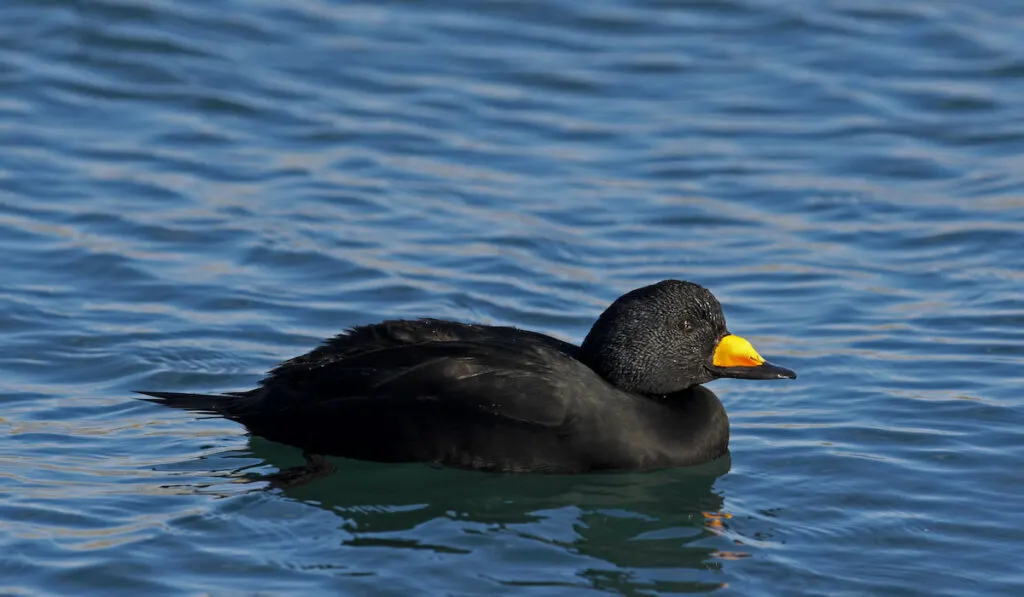
- Migration pattern: They breed in North America, Alaska, and east of the Yana River in Siberia through May and June. Black Scoters winter on the Canadian coast, north America, San Francisco Bay, the Gulf of Mexico, and Asia down to Japan, Korea, and China.
- Male color: Black all over their bodies with a bright yellow knob on their bills.
- Female color: Shades of brown all over their bodies with black bills.
- Diet: Aquatic invertebrates
- Habitat: Lakes and rivers
- Weight: 38.4 oz (2.4 lbs)
- Length: 17 – 21 inches
- Wingspan: 30 – 35 inches
- Nesting: Ground
- Clutch size: 8 to 9 eggs
- Incubation period: 27 to 28 days
- Lifespan: 16.8 years
17. Canvasback (Aythya valisineria)
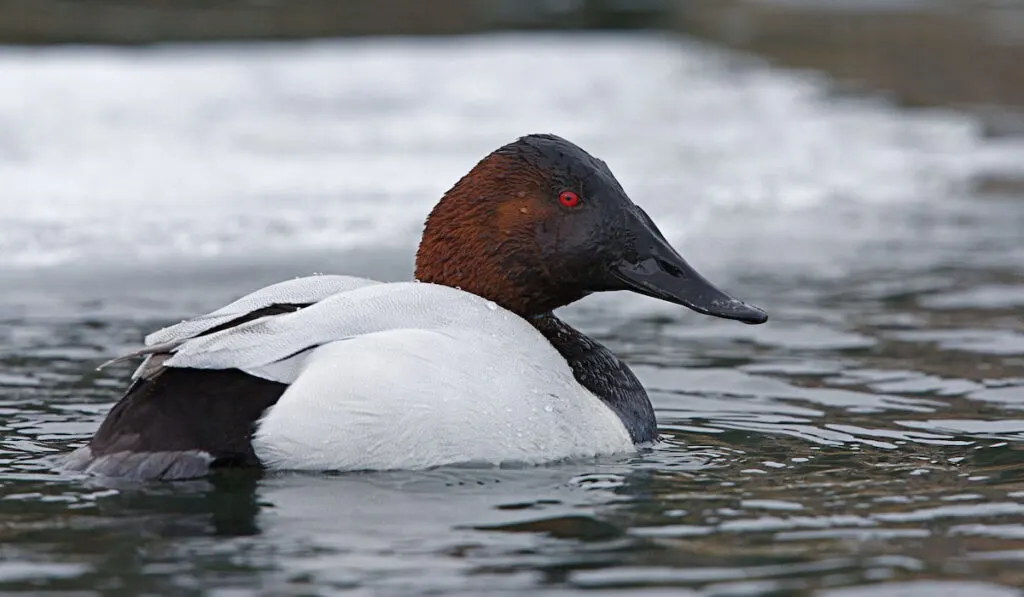
- Migration pattern: Canvasbacks breed through May to early June in western and northcentral Canada before migrating to the south, east, and west parts of North America, and Mexico.
- Male color: Red eyes, reddish brown heads and throats, black chests, canvas gray bellies and backs
- Female color: Brown heads, throats, and chests with brown and gray backs and bellies.
- Diet: Plants
- Habitat: Lakes and ponds
- Weight: 58 oz (3.6lbs)
- Length: 19 – 24 inches
- Wingspan: 28 – 36 inches
- Nesting: Floating
- Clutch size: 5 to 11 eggs
- Incubation period: 24 to 26 days
- Lifespan: Up to 16 years
Sea Ducks
This wonderfully colorful duck group can be found in coastal habitats and is well-equipped to endure low temperatures while at sea.
Identifying Sea Ducks
While living in sometimes very harsh conditions, sea ducks seem to be sensational survivors. To combat the very low temperatures at sea, these ducks are nicely insulated with thick, fluffy down.
They also have an amazing system in their legs that allows arteries and veins to heat cold blood before it returns to their bodies.
But why don’t all ducks swim and feed in the sea? Well, it’s because the high salt quantities would kill your average duck, but sea ducks have evolved to deal with this problem.
Sea ducks have an extra gland just above their eyes that draws salt ions out of their bloodstream, allowing them to drink seawater without being affected.
Sea ducks can only use this ability when they are mature enough. Young sea ducks are hatched and raised away from the sea until they develop the glands necessary for removing salt from water.
Some species of sea duck have long, serrated bills perfect for catching fish, while others have hefty, strong bills that enable them to eat mussels, scallops, and other bivalves. These unique creatures can dive to depths of 164 feet (50 meters)!
18. Common Eider (Somateria mollisima)
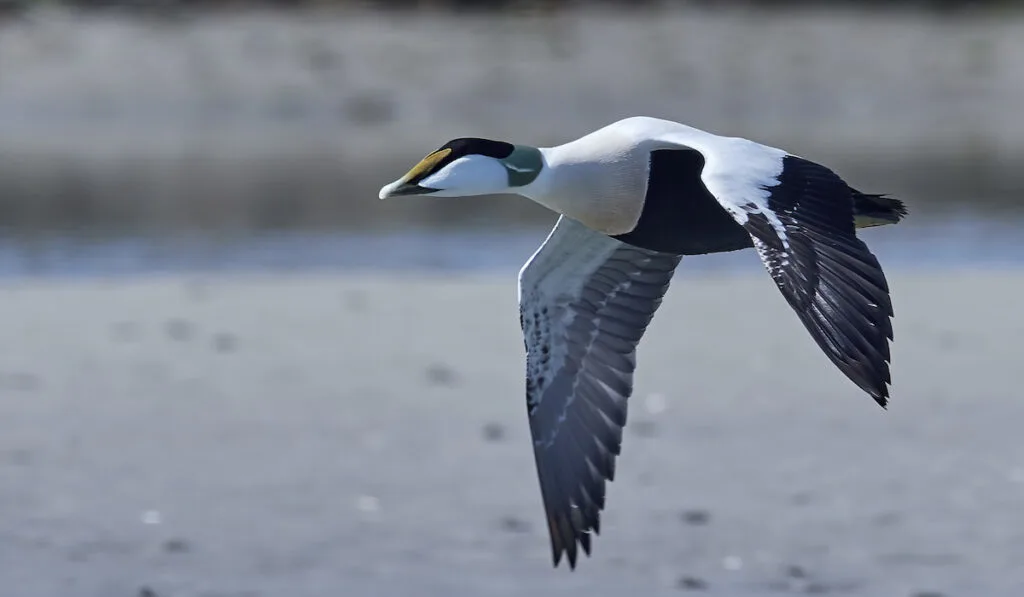
- Migration pattern: Canada, Alaska, and portions of northern Europe and Asia during the breeding season. Some spend the entire winter in these places, while others go south.
- Male color: Black caps, sides, bellies, white cheeks, necks, backs, and chests. The back of their necks is a pistachio color.
- Female color: Shades of brown all over with hints of black.
- Diet: Aquatic invertebrates
- Habitat: Oceans
- Weight: 78.4 oz (4.9 lbs)
- Length: 23 – 27 inches
- Wingspan: 35 – 42 inches
- Nesting: Ground
- Clutch size: 3 to 8 eggs
- Incubation period: 24 to 26 days
- Lifespan: Up to 20 years
19. Spectacled Eiders (Somateria fischeri)
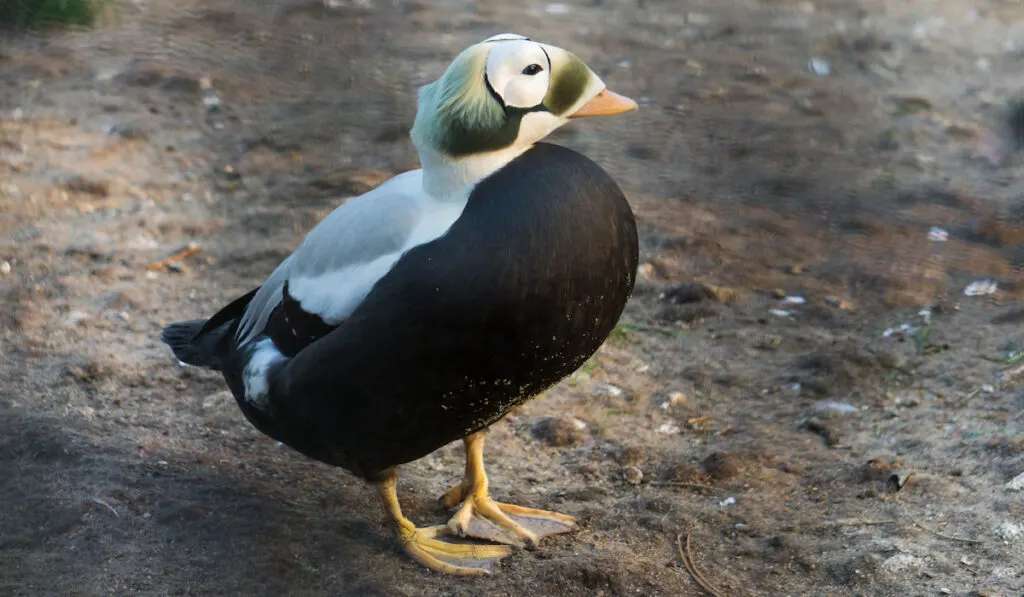
- Migration pattern: They breed from late May or June in the Arctic coastal tundra, Alaska, and the northeast of Siberia. They winter in the Bering Sea.
- Male color: White faces with goggles outlined in black, bright orange bills, greenish-colored feathers at the back of their heads, black bottom half of their bodies, white upper half.
- Female color: Dark bills, light brown heads and goggles, golden brown bodies with black lines everywhere.
- Diet: Aquatic invertebrates
- Habitat: Coastal waters, the Bering Sea
- Weight: 51.2 oz (3.2 lbs)
- Length: 20 – 23 inches
- Wingspan: 30 – 36 inches
- Nesting: Ground
- Clutch size: 1 to 11 eggs
- Incubation period: 23 days
- Lifespan: Up to 15 years
20. King Eider (Somateria spectabilis)
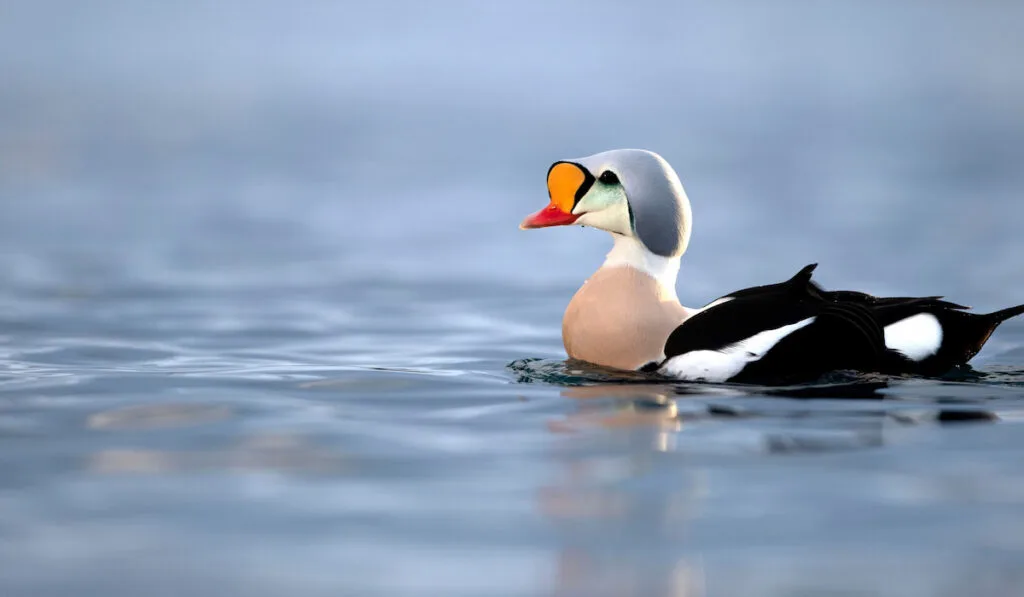
- Migration pattern: Breeding season for the King Eider is spent in the arctic tundra, coastal areas of Canada, Alaska, Greenland, and northern coasts of Russia and Siberia. This bird winters in the Bering Sea, St. Lawrence Island, west Greenland, Iceland, and northern Norway.
- Male color: Greenish face with bright orange knob outlined in black above their red bills, white chests, black wings, bellies, back, white patches on their wings and tail.
- Female color: Black bill, brown cheeks and neck, shades of brown all over their bodies in intricate patterns.
- Diet: Aquatic invertebrates
- Habitat: Oceans
- Weight: 59.2 oz (3.7 lbs)
- Length: 18 – 25 inches
- Wingspan: 35 – 40 inches
- Nesting: Ground
- Clutch size: 2 to 7 eggs
- Incubation period: 23 to 30 days
- Lifespan: Up to 24 years
21. Barrow’s Goldeneye (Bucephala islandica)
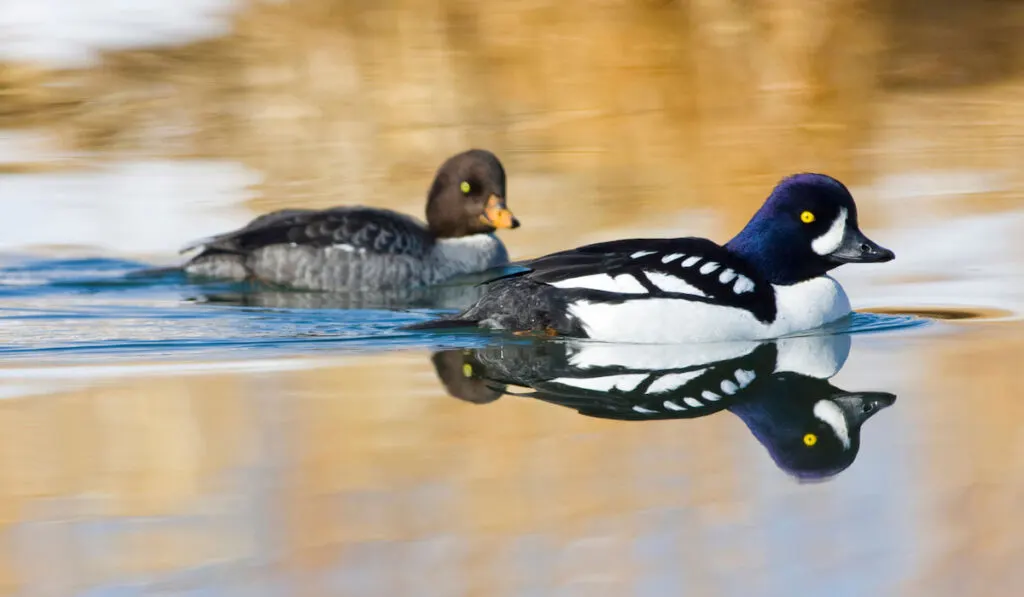
- Migration pattern: Breeding from May in the west of North America – Canada, eastern North America, Greenland, and Iceland, while heading to south-western Greenland, and south of Iceland for winter.
- Male color: Black heads with a purple sheen, black bill with crescent white patch at the base, yellow eyes, white chests and bellies, black top half with white shoulders.
- Female color: White neck collar, dark brown heads, yellow-orange bills, yellow eyes, gray bodies, and white shoulder bars.
- Diet: Aquatic invertebrates
- Habitat: Lakes and oceans
- Weight: 35.3 – 45.9 oz (2.2 – 2.8 lbs)
- Length: 19.7 – 25.6 inches
- Wingspan: 32.3 – 37.4 inches
- Nesting: Cavity
- Clutch size: 6 to 12 eggs
- Incubation period: 29 to 31 days
- Lifespan: Up to 18 years
22. Bufflehead (Bucephala albeola)
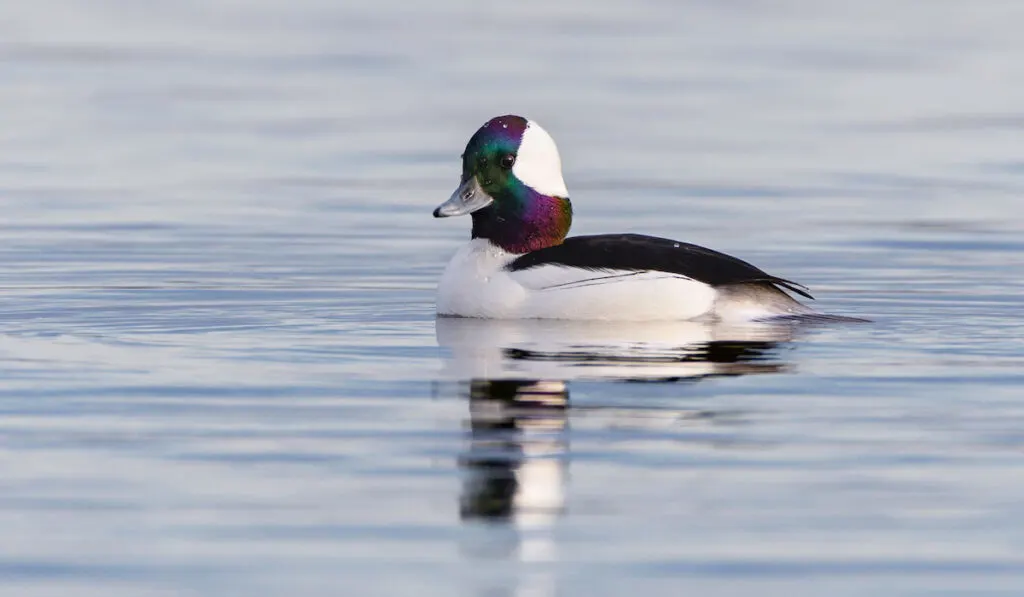
- Migration pattern: Breeding May to June in Alaska and Canada. Winters in North America and Mexico.
- Male color: Glossy greenish-purple sheen on the crown, throat, and neck, a large white area at the back of their heads; the top half of their bodies is black, and the bottom half is white.
- Female color: Blackish-brown heads with white cheeks, their bodies are halved in gray and black.
- Diet: Aquatic invertebrates
- Habitat: Lakes, rivers, coastal waters
- Weight: 21.2 oz (1.3 lbs)
- Length: 13 – 16 inches
- Wingspan: 20 – 24 inches
- Nesting: Cavity
- Clutch size: 4 to 17 eggs
- Incubation period: 23 to 30 days
- Lifespan: Average of 2.5 years
23. Harlequin Duck (Histrionicus histrionicus)
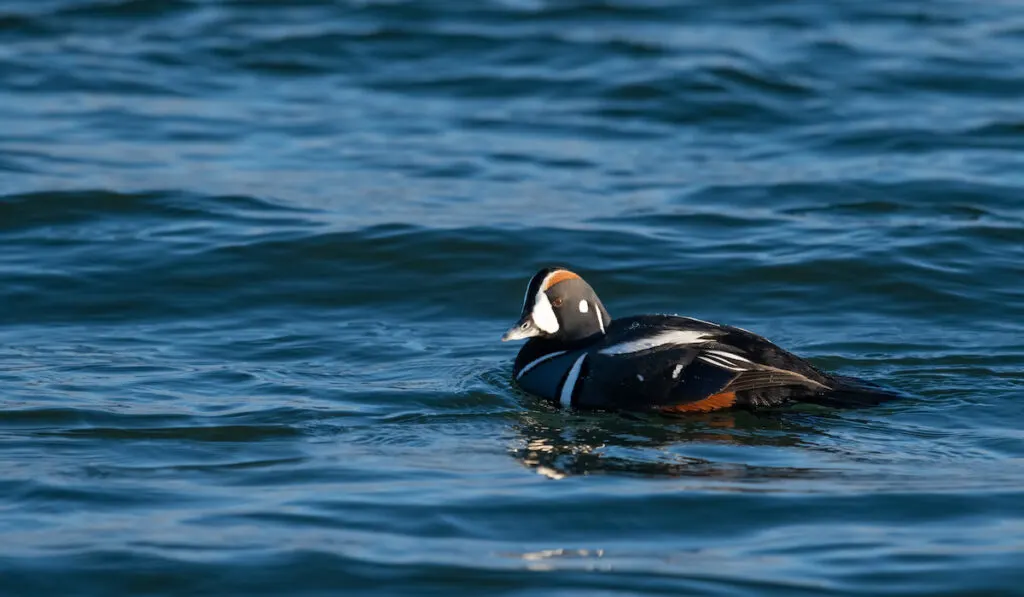
- Migration pattern: Breeding from June on eastern and western Canadian coastlines and wintering in northeastern America.
- Male color: Grayish blue head, neck, and bodies with reddish sides and crown, white stripes on their bodies, and face with black outlines.
- Female color: Brown all over with three white dots on their heads.
- Diet: Aquatic invertebrates
- Habitat: Rivers, coastal waters
- Weight: 24 oz (1.5 lbs)
- Length: 15 – 21 inches
- Wingspan: 26 – 28 inches
- Nesting: Ground
- Clutch size: 4 to 8 eggs
- Incubation period: 27 to 29 days
- Lifespan: Up to 14 years
Shelducks
Shelducks are mostly found in countries in the southern hemisphere, such as Australia, Tasmania, and New Zealand, but there are a couple of breeds in the northern hemisphere as well.
Identifying Shelducks
Shelducks are easy to identify because they are a large duck species, bigger than a mallard and smaller than a goose.
They stand upright, much like geese, and male shelducks use the bony knob on their short bills to whistle while courting and being aggressive.
As they are very sociable creatures, shelducks remain with a chosen partner for extended periods and have large broods.
This duck species is omnivorous, and much like common dabblers, they also like shallow waters. When they are not digging in the mud at the edge of a lake or pond looking for food, they are on the water feeding on plant matter, aquatic insects, and crustaceans.
24. Ruddy Shelduck (Tadorna ferruginea)
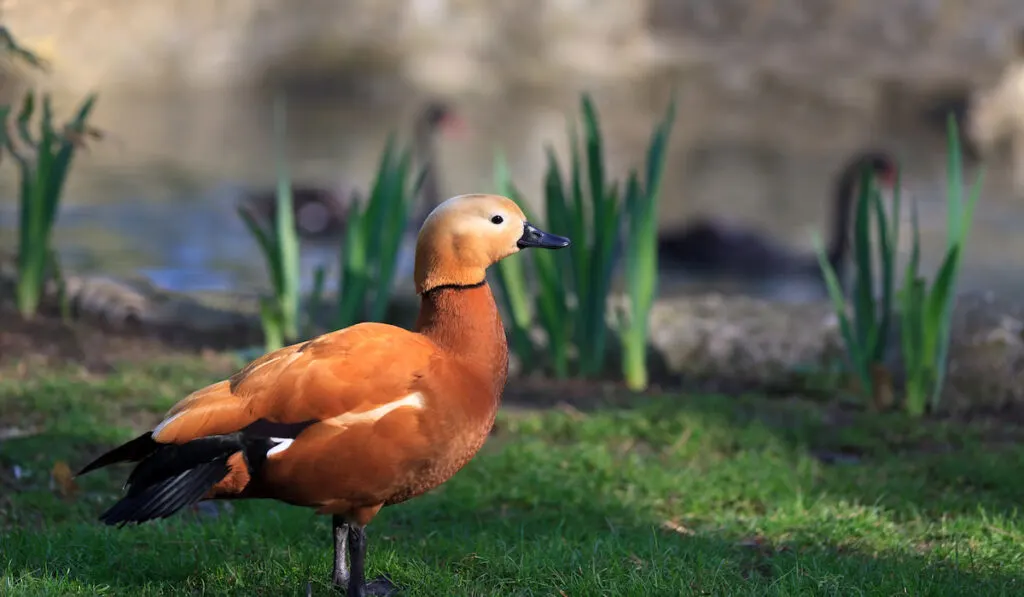
- Migration pattern: Breeding from April to May in south-east Europe, Central Asia and North Africa while wintering in the south of Asia and the Nile Valley.
- Male color: A rusty brown body, black tail feathers, black bill, white face, black neck collar, white wings with black feathers.
- Female color: Rusty brown body, black tail feathers, black bill, white face, white wings with black feathers.
- Diet: Aquatic invertebrates and plants
- Habitat: Lakes, ponds, rivers
- Weight: 35.3 – 45.9 oz (2.2 – 2.8 lbs)
- Length: 23 – 27 inches
- Wingspan: 43 – 53 inches
- Nesting: Ground
- Clutch size: 6 to 16 eggs
- Incubation period: 22 to 28 days
- Lifespan: Up to 13 years
25. Common Shelduck (Tadorna tadorna)
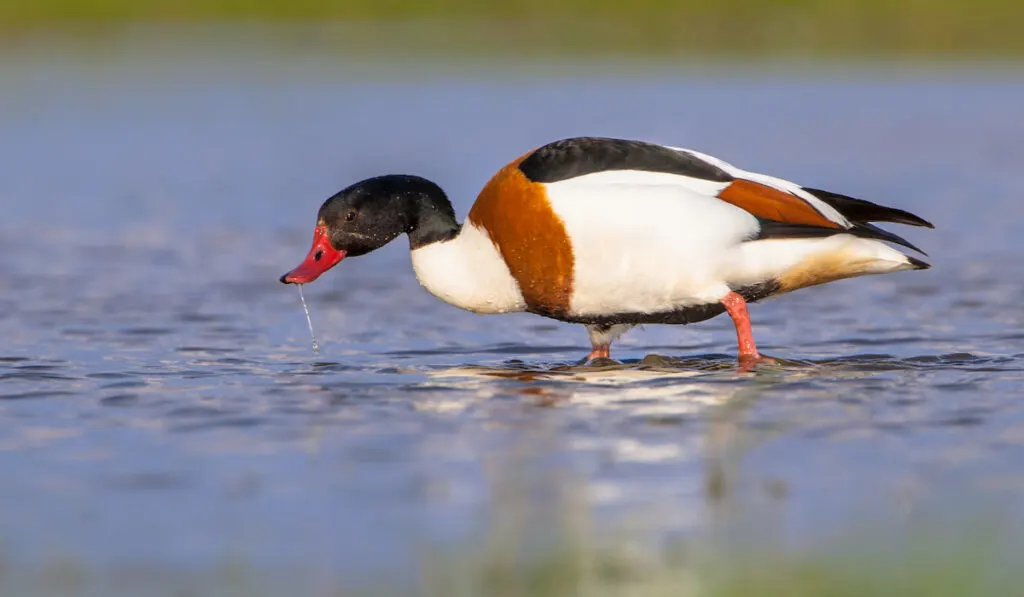
- Migration pattern: Breeding from early May the Common Shelduck frequents the UK and north-west Europe, Germany, the Balkans, Asia, and northern China. Winters in the Mediterranean, North Africa, Pakistan, northern India, Nepal, south-eastern China, and South Korea.
- Male color: A dark green neck and head, a white chest with a large brown stripe, a white belly and back, pink legs, and a red bill.
- Female color: A dark green neck and head, a white chest with a large brown stripe, a white belly and back, pink legs, and a red bill.
- Diet: Aquatic invertebrates
- Habitat: Lakes and ponds
- Weight: 35.2 oz (2.2 lbs)
- Length: 20 – 24 inches
- Wingspan: 33 – 39 inches
- Nesting: Ground
- Clutch size: 7 to 12 eggs
- Incubation period: 23 to 32 days
- Lifespan: 5 to 10 years
Perching Ducks
Perching ducks are usually found close to lakes and rivers in forested areas, and they build their nests in hollow tree trunks far above the ground.
Identifying Perching Ducks
Perching ducks share similarities with other duck species, like dabblers and shelducks, but they have strong claws on their toes that allow them to spend a lot of time perched in trees.
Due to their impressive colors and patterns, perching ducks are sometimes kept as ornamental waterfowl.
Depending on the season, perching ducks consume a lot of grains and aquatic plants. Rice, buckwheat, pines, grapes, seeds, and roses are a significant part of their diet.
26. Wood Duck (Aix sponsa)
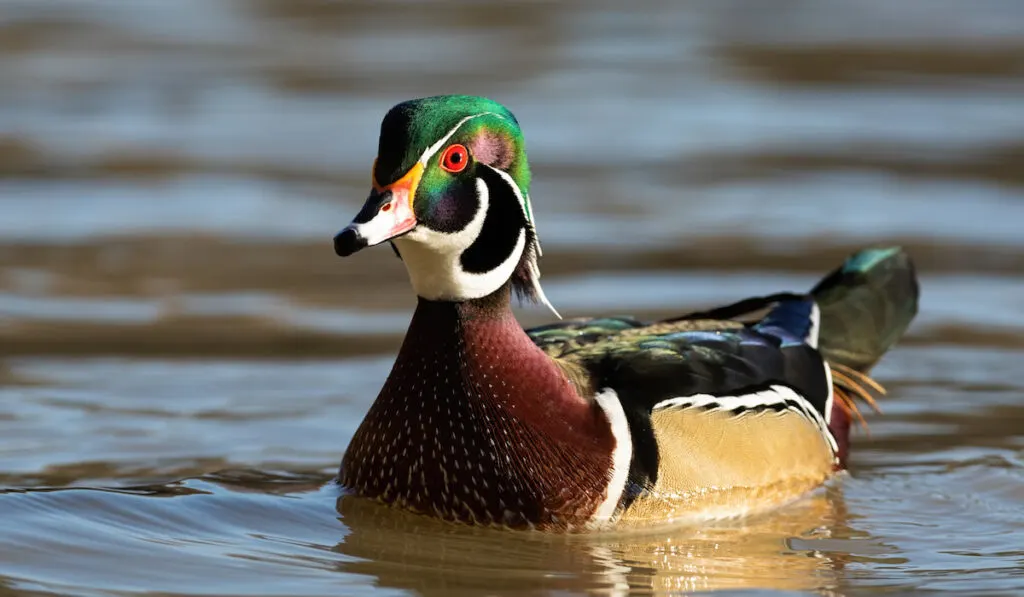
- Migration pattern: Breeding from February to May in the east of North America and along the Pacific Coast, while wintering in Mexico.
- Male color: A crest at the back of their heads, with iridescent green markings that continue down the neck, white around the throat, and chestnut brown at the chest.
- Female color: Brown bodies with grayish brown heads, white around the eyes and blue patches on their wings.
- Diet: Plants
- Habitat: Lakes, ponds, and forests
- Weight: 16 – 30 oz (1 – 1.8 lbs)
- Length: 18.5 – 21.3 inches
- Wingspan: 26 – 28.7 inches
- Nesting: Cavity
- Clutch size: 6 to 16 eggs
- Incubation period: 23 to 30 days
- Lifespan: 3 to 15 years
27. Mandarin Duck (Aix galericulata)
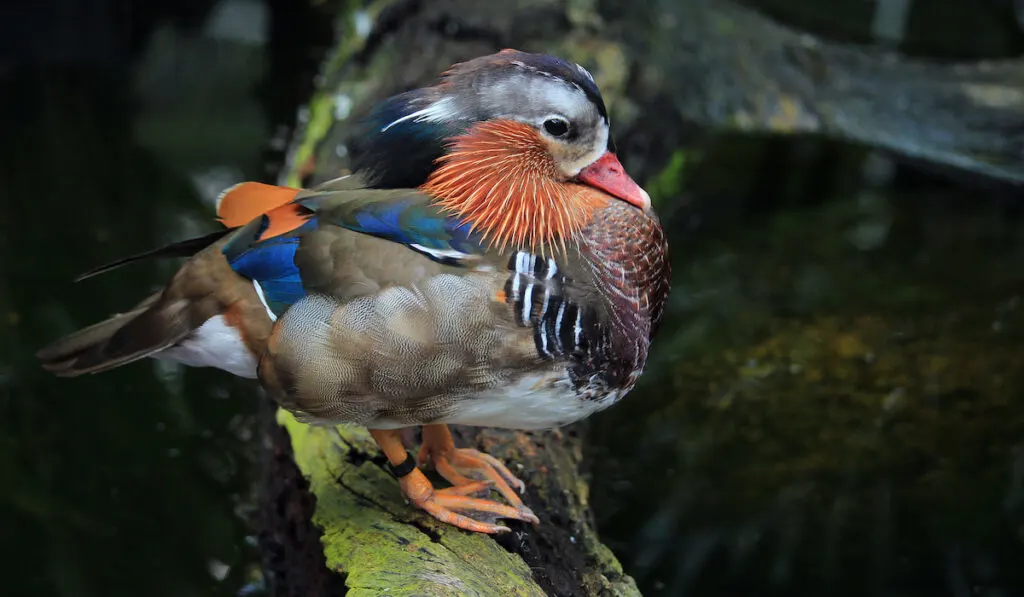
- Migration pattern: Originating in south-eastern Russia, north-eastern China, Japan, and Taiwan, the Mandarin Duck winters in south-eastern China. New populations have been formed in the UK and the USA.
- Male color: A beautiful bird with a patchwork of colors that blend into each other. Mandarin ducks have signature features like throat feathers, long crests, and a light orange sail at the rear.
- Female color: Brown bodies, blue bills, and grayish-brown heads.
- Diet: Omnivore
- Habitat: Lakes, ponds, and forests
- Weight: 15 – 24 oz (0.9 – 1.5 lbs)
- Length: 16 – 19 inches
- Wingspan: 26 – 30 inches
- Nesting: Cavity
- Clutch size: 9 to 12 eggs
- Incubation period: 23 to 30 days
- Lifespan: Up to 10 years
Stifftails
Usually found in warmer climates, stiff-tailed ducks are compact ducks that use their stiff tail feathers to steer themselves underwater while diving for food.
Identifying Stifftails
While stifftails have a body shape ideal for diving and underwater swimming, they struggle to move around on land. Their legs are set back closer to their tailfeathers and have smaller wings than other duck species. They prefer to take off and land on the water instead of on land.
These divers like to feed on seeds, tubers, leafy pondweed, bulrush, widgeon grass, musk grass and while most of their diet is vegetarian, they also eat midge larvae.
28. Ruddy Duck (Oxyura jamaicensis)
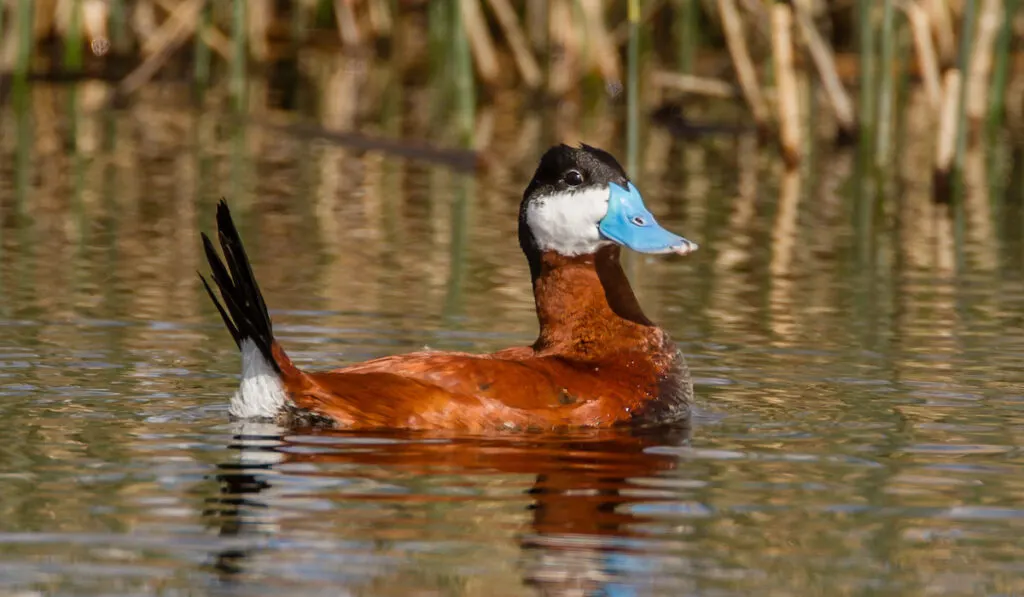
- Migration pattern: From mid-April to July, Ruddy ducks breed in the western US, West Indies, the Andes in South America, the UK, and parts of Europe. They migrate to the south, east, and west coasts of America and Mexico.
- Male color: Bright blue bills, black caps, white faces, and a body full of golden-copper and chestnut brown.
- Female color: Shades of grayish brown all over their bodies with a dark bill.
- Diet: Aquatic invertebrates
- Habitat: Marshes
- Weight: 28.4 oz (1.7 lbs)
- Length: 14 – 16 inches
- Wingspan: 21 – 24 inches
- Nesting: Ground
- Clutch size: 3 to 13 eggs
- Incubation period: 21 to 26 days
- Lifespan: Up to 13 years
Final Thoughts
When you look at the statistics of these wonderful birds, they are truly awe-inspiring. Whether it’s their ability to travel enormous distances during migration periods or how they adapt to sometimes very harsh environments while maintaining an incredible natural beauty, ducks truly deserve our respect.
From dabbling ducks to divers and beyond, no matter where you are in the world, if there is water nearby, there are sure to be some ducks enjoying the natural habitat that surrounds it.
Resources
- https://www.birdspot.co.uk/identifying-birds/types-of-ducks
- http://www.wildfowl-photography.co.uk/wildfowl/mallard.htm
- https://www.birdadvisors.com/mallard/
- https://animalia.bio/american-black-duck
- https://www.allaboutbirds.org/guide/American_Black_Duck/lifehistory
- https://www.birdadvisors.com/american-black-duck/
- https://www.allaboutbirds.org/guide/Cinnamon_Teal
- https://www.birdadvisors.com/cinnamon-teal/
- https://www.allaboutbirds.org/guide/Gadwall/lifehistory
- https://www.birdadvisors.com/gadwall/
- https://www.birdadvisors.com/northern-pintail/
- https://www.allaboutbirds.org/guide/Northern_Pintail
- http://www.wildfowl-photography.co.uk/wildfowl/pintail.htm
- http://www.wildfowl-photography.co.uk/wildfowl/american-wigeon.htm
- https://www.allaboutbirds.org/guide/American_Wigeon/lifehistory
- https://www.birdadvisors.com/american-wigeon/
- https://www.birdadvisors.com/black-bellied-whistling-duck/
- https://www.birdadvisors.com/redhead/
- https://www.allaboutbirds.org/guide/Redhead/lifehistory
- http://www.wildfowl-photography.co.uk/wildfowl/goosander.htm
- https://www.allaboutbirds.org/guide/Common_Merganser
- https://www.birdadvisors.com/common-merganser/
- http://www.wildfowl-photography.co.uk/wildfowl/red-breasted-merganser.htm
- https://www.birdadvisors.com/red-breasted-merganser/
- https://www.allaboutbirds.org/guide/Red-breasted_Merganser/lifehistory
- https://www.birdadvisors.com/common-goldeneye/
- https://www.allaboutbirds.org/guide/Common_Goldeneye
- http://www.wildfowl-photography.co.uk/wildfowl/northern-shoveler.htm
- https://www.allaboutbirds.org/guide/Northern_Shoveler/lifehistory
- https://www.birdadvisors.com/northern-shoveler/
- http://www.wildfowl-photography.co.uk/wildfowl/green-winged-teal.htm
- https://www.birdadvisors.com/green-winged-teal/
- https://www.birdadvisors.com/mottled-duck/
- http://www.wildfowl-photography.co.uk/wildfowl/mottled-duck.htm
- https://www.allaboutbirds.org/guide/Mottled_Duck
- http://www.wildfowl-photography.co.uk/wildfowl/eurasian-wigeon.htm
- https://www.allaboutbirds.org/guide/Eurasian_Wigeon/lifehistory
- https://www.birdadvisors.com/eurasian-wigeon/
- http://www.wildfowl-photography.co.uk/wildfowl/goldeneye.htm
- http://www.wildfowl-photography.co.uk/wildfowl/ruddy-duck.htm
- https://www.allaboutbirds.org/guide/Ruddy_Duck/lifehistory
- https://www.birdadvisors.com/ruddy-duck/
- https://www.birdadvisors.com/black-scoter/
- https://www.allaboutbirds.org/guide/Black_Scoter
- http://www.wildfowl-photography.co.uk/wildfowl/black-scoter.htm
- http://www.wildfowl-photography.co.uk/wildfowl/canvasback.htm
- https://www.birdadvisors.com/canvasback/
- https://www.allaboutbirds.org/guide/Canvasback/lifehistory
- https://www.birdadvisors.com/common-eider/
- https://www.allaboutbirds.org/guide/Common_Eider/
- http://www.wildfowl-photography.co.uk/wildfowl/eider.htm
- http://www.wildfowl-photography.co.uk/wildfowl/spectacled-eider.htm
- https://www.allaboutbirds.org/guide/Spectacled_Eider/lifehistory
- https://www.birdadvisors.com/spectacled-eider/
- https://www.birdadvisors.com/king-eider/
- https://www.allaboutbirds.org/guide/King_eider
- http://www.wildfowl-photography.co.uk/wildfowl/king-eider.htm
- http://www.wildfowl-photography.co.uk/wildfowl/barrows-goldeneye.htm
- https://www.allaboutbirds.org/guide/Barrows_Goldeneye/lifehistory
- https://www.birdadvisors.com/barrows-goldeneye/
- https://www.birdadvisors.com/bufflehead/
- https://www.birdadvisors.com/harlequin-duck/
- https://www.allaboutbirds.org/guide/Harlequin_duck
- http://www.wildfowl-photography.co.uk/wildfowl/harlequin-duck.htm
- http://www.wildfowl-photography.co.uk/wildfowl/ruddy-shelduck.htm
- http://www.wildfowl-photography.co.uk/wildfowl/shelduck.htm
- http://www.wildfowl-photography.co.uk/wildfowl/shelduck.htm
- http://www.wildfowl-photography.co.uk/wildfowl/americanwoodduck.htm
- https://www.birdadvisors.com/wood-duck/
- http://www.wildfowl-photography.co.uk/wildfowl/mandarin.htm
- https://www.birdadvisors.com/mandarin-duck/
